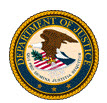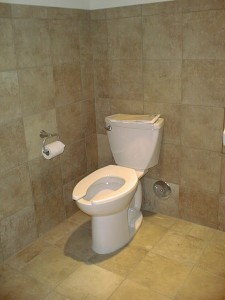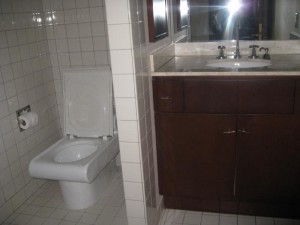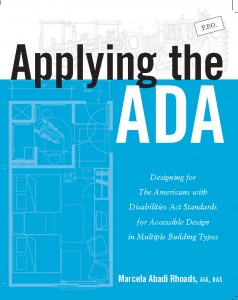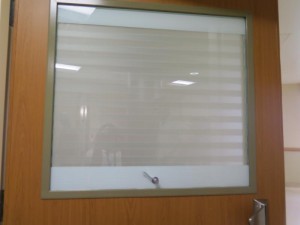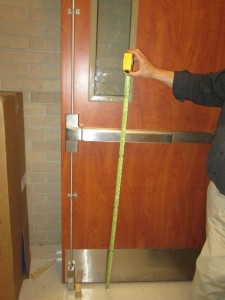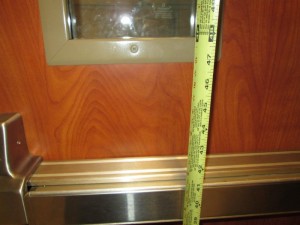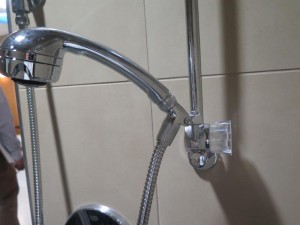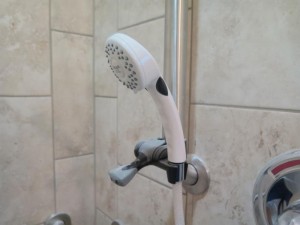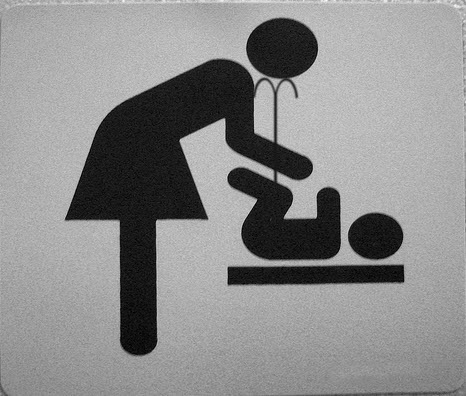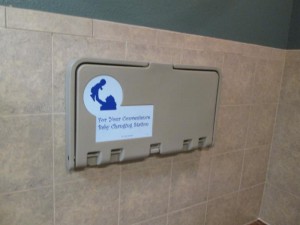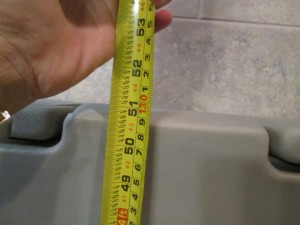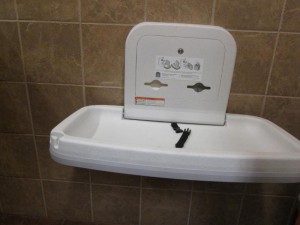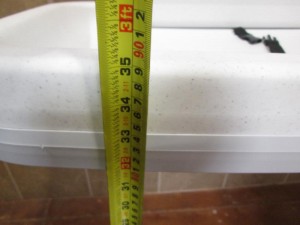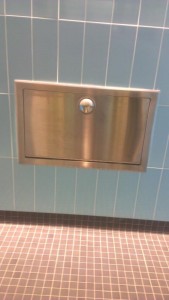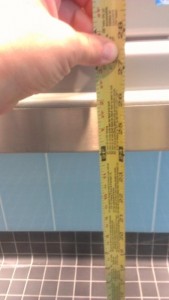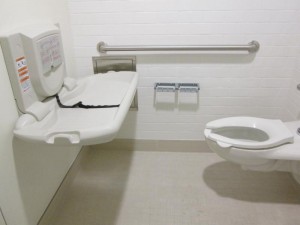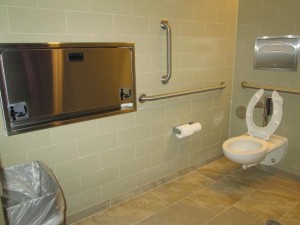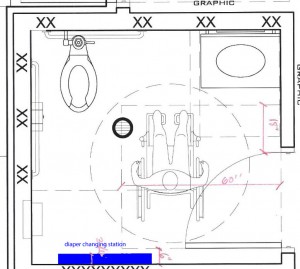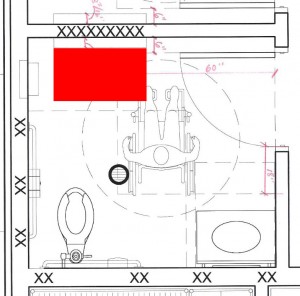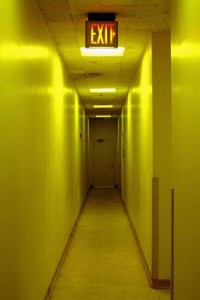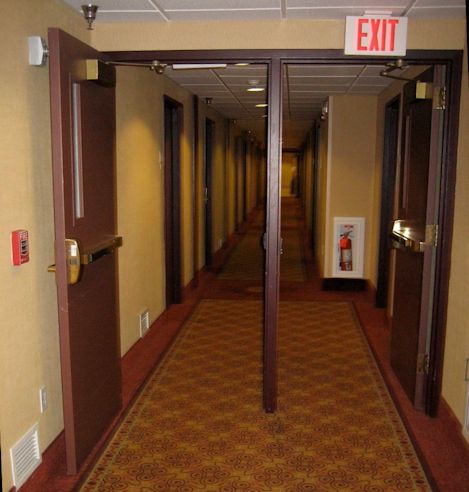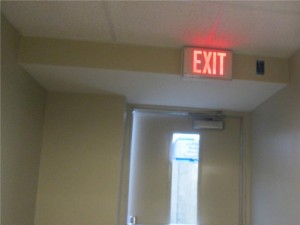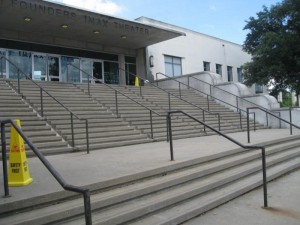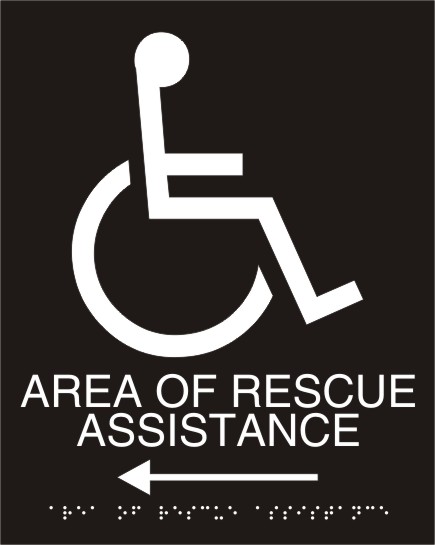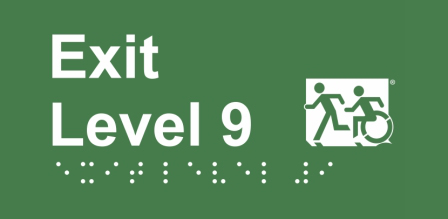There is a lot of confusion in the ADA on what clearances and elements are allowed to overlap each other. The main idea for restrictions to having elements overlap is the inability for a person in a wheelchair to use the element or the space efficiently. The amount of clearance that we design by translates to the amount of space that should be provided for one wheelchair. Floor clearances are not fixed elements and if they overlap each other it does not impede the usage of the clearance. But if a fixed element overlaps the clearance, that might reduce the clearance and prevents a person from using the element.
This newsletter will explain which elements can overlap since they don’t impede the usage of the space or element, and which ones may not overlap. All the rulings are taken from the 2010 ADA Standards
Door Swings
The ADA allows a door to swing into the turning space.
304.4 Door Swing. Doors shall be permitted to swing into turning spaces.
The turning space is not a fixed object. It essentially can move anywhere in a space. Therefore the door swing is not required to avoid it. It can swing into it as much as it needs to.
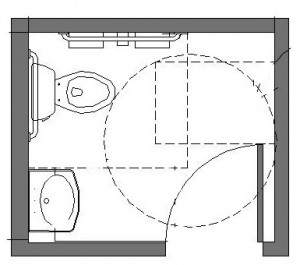
The ADA The plan of the restroom shows a door swinging into the turning space.
But a door may not swing into the clearance of a plumbing fixture or any fixture within the toilet room. This ensures that if a person in a wheelchair is washing their hands at a lavatory near the door that swings into the toilet room, that person will not get hit by the door.
603.2.3 Door Swing. Doors shall not swing into the clear floor space or clearance required for any fixture. Doors shall be permitted to swing into the required turning space.
There are a couple of exceptions. If the the toilet room is a private office or a single user restroom, it is assumed that the person inside will lock the door behind them and therefore the chances of getting hit by a door while using a fixture that is located within the door swing is unlikely.
EXCEPTIONS:
1. Doors to a toilet room or bathing room for a single occupant accessed only through a private office and not for common use or public use shall be permitted to swing into the clear floor space or clearance provided the swing of the door can be reversed to comply with 603.2.3.
2. Where the toilet room or bathing room is for individual use and a clear floor space complying with 305.3 is provided within the room beyond the arc of the door swing, doors shall be permitted to swing into the clear floor space or clearance required for any fixture.
In addition, there might be two doors within a restroom. It could be a second entry door, but also a toilet compartment door. The clearances for each door may overlap each other, but also they may overlap the turning space. As long as they meet the maneuvering requirements, they may also overlap fixtures.
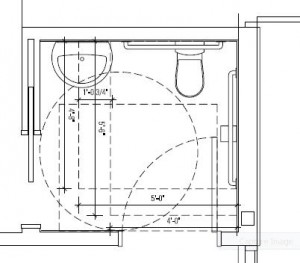
The plan above shows a swing door and a sliding door in the same restroom. The rules for sliding doors are the same as a swing door.
In a toilet compartment, the door swing cannot overlap the floor clearance of the water closet. If the door swings into the clearance of a water closet inside the compartment will impede maneuvering inside the compartment.
604.8.1.1 Size. Wheelchair accessible compartments shall be 60 inches (1525 mm) wide minimum measured perpendicular to the side wall, and 56 inches (1420 mm) deep minimum for wall hung water closets and 59 inches (1500 mm) deep minimum for floor mounted water closets measured perpendicular to the rear wall
604.8.1.2 Doors. …….Toilet compartment doors shall not swing into the minimum required compartment area
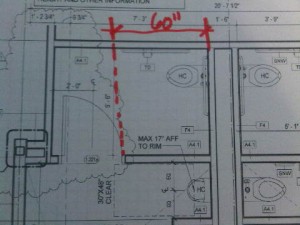
The clearance of the water closet in a compartment should be either 56″ for a wall hung or 59″ if it’s floor mounted. The door can swing out and can also swing in, but the door may not swing into that minimum clearance.
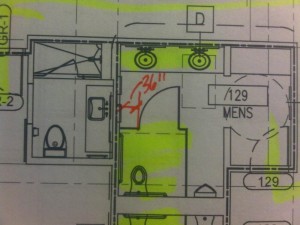
The toilet compartment door shown in the drawing above is swinging into the clearance of the lavatory. Toilet compartment doors must also meet the requirements for section 404 for maneuvering, but there is no restriction to swinging the door into the facing fixtures. That requirements is for the entry door to the toilet room.
What is allowed to overlap in a restroom?
In a toilet room, the floor space and other clearances including the turning space can overlap each other.
603.2.2 Overlap. Required clear floor spaces, clearance at fixtures, and turning space shall be permitted to overlap.

The required clearance around the water closet shall be permitted to overlap the water closet, associated grab bars, dispensers, sanitary napkin disposal units, coat hooks, shelves, accessible routes, clear floor space and clearances required at other fixtures, and the turning space.
No other fixtures or obstructions shall be located within the required water closet clearance.
The photo above shows a floor clearance of 60″ at the water closet, but there is a paper towel dispenser that is within. That dispenser is not allowed to overlap the clearance.
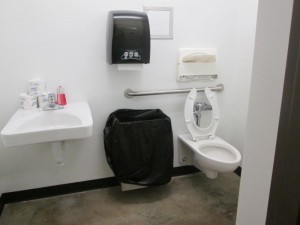
The photo above shows the lavatory within the clearance of the water closet, but in addition there is a fixed trash can and paper towel dispensers within the floor clearance. This is not acceptable.
There is one exception, and that is in residential dwelling units. But this is not for a Fair Housing or ANSI Residential unit. This is the residential dwellings that are scoped in the ADA such as faculty and director apartments in places of education and sleeping quarters in emergency personnel faciliities.
EXCEPTION: In residential dwelling units, a lavatory complying with 606 shall be permitted on the rear wall 18 inches (455 mm) minimum from the water closet centerline where the clearance at the water closet is 66 inches (1675 mm) minimum measured perpendicular from the rear wall.
Need CEUs
If you are interested in Building Code seminars check out my colleague Shahla Layendecker with
SSTL CodesIf you want to learn more about these standards, be sure to check out my books:
Monday, November 2nd, 2015
In the 2010 ADA Standards and the 2012 TAS, certain elements that are associated with fitness centers and recreation centers were added to the requirements for accessibility. Some of these elements were exercise equipment, saunas, swimming pools, and even team player seating.
Most of the time when I am inspecting the project, the owners will inquire the reasons why their facility must be accessible since fitness centers typically for able bodied patrons. What they sometimes don’t understand is that there are different levels of ability that persons with disabilities possess. There are some very active people that use wheelchairs, walkers, crutches or canes. Just because they are in a wheelchair or may have other mobility issues does not mean that they also should not enjoy going to a rec center or fitness center.
This newsletter will explain a few of the requirements and attempt to clarify some of the misconceptions.
Exercise equipment
ADA 1004.1 Clear Floor Space. Exercise machines and equipment shall have a clear floor space complying with 305 [30″x48″ and no changes in level] positioned for transfer or for use by an individual seated in a wheelchair. Clear floor or ground spaces required at exercise machines and equipment shall be permitted to overlap.
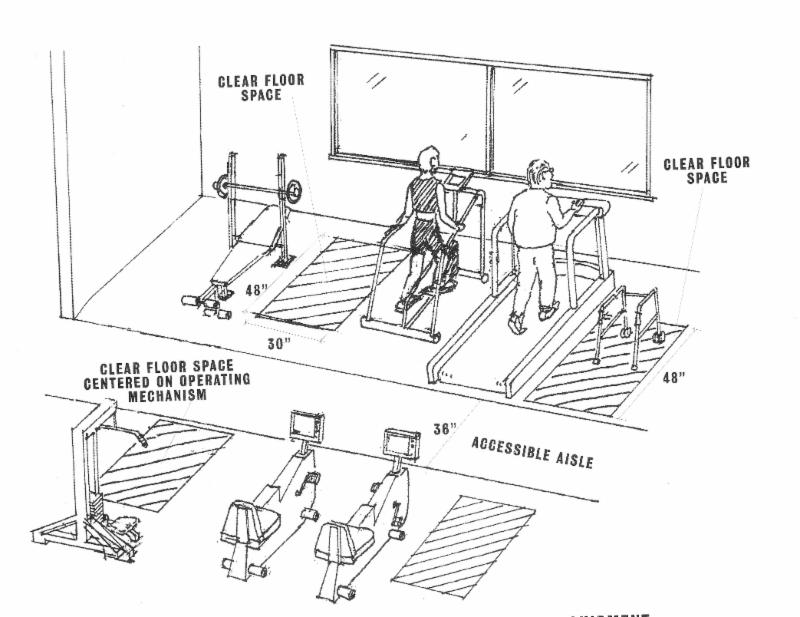
Each type of equipment must have the clear floor space next to it, but two pieces of equipment can share the space.
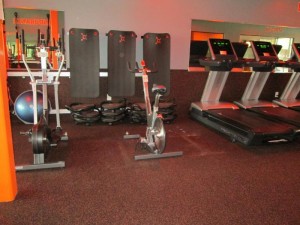
It is not necessary for the clear floor space to be located adjacent each piece of equipment. One of each type is all that is required. The photo above shows several tread mills but only one is required to have the clear floor space, and it is also being shared with the stationary bike.
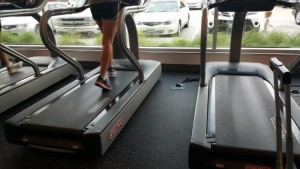
The clear floor space of this treadmill was narrower than 30″. This is a simple fix of just moving over the equipment to achieve compliance.
Amenities
Rec Centers and fitness centers typically have a reception desk where they will check people in. This is considered a “service counter” and therefore must meet the requirements for ADA Section 904. A portion of the counter must be at 36″ a.f.f. maximum and be no shorter than 36″ wide.
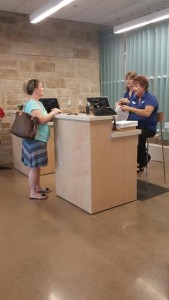
This reception counter does not have an accessible portion at the public side. The lower counter where the attendant is seated is part of the work area, and could possibly be used as the accessible counter if it was 36″ long.
5% of lockers that are provided must have the proper hardware that does not require tight grasping and twisting of the wrist to operate. In addition, those accessible lockers must be within reach range.
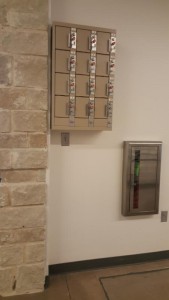
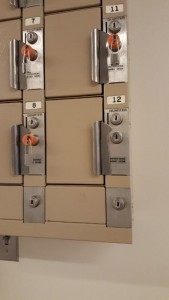
This locker is mounted higher than the required 48″ a.f.f. and the operable part (the key) is the type that requires tight grasping and twisting of the wrist to open.
Fitness Centers also have locker rooms and toilet/shower rooms that are provided. The locker rooms must have accessible lockers (within reach range and type of operation) as well as an accessible bench per section 903
Showers and other restroom facilities will also require access. I did a newsletter about this shower seats.
Click here for the archive.Swimming pools and spas are also sometimes provided at rec centers/fitness centers. I discussed swimming pools in a separate newsletter.
Click here for the archiveNo Limits!
So when they ask you, why are you designing golf courses, tennis courts, rec centers and swimming pools for the disabled, remind them that there are some awesome athletes that do things just a little differently!
Upcoming Continuing Education Opportunities
November 5 and 6: “Texas Accessibility Standards: A Success story of inclusion for over 20 years” TxA convention in Dallas, Texas
November 17th: “Applying the ADA on Existing and Altered Buildings” provided by Green CE
On Demand Webinar: “Understanding the 2010 ADA Standards for Accessible Design”
If you are interested in Building Code seminars check out my colleague Shahla Layendecker with SSTL Codes
If you want to learn more about these standards, be sure to check out my books:
“The ADA Companion Guide” “Applying the ADA” published by Wiley.
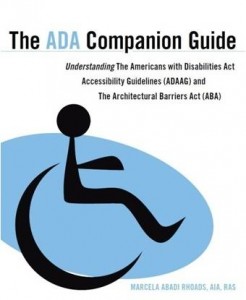
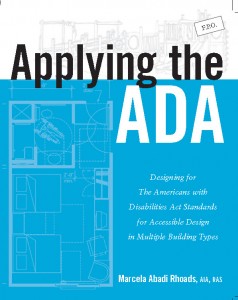
They are available for sale now. (also available as an e-book)
If you have any questions about these or any other topics, please feel free to contact me anytime.
Marcela Abadi Rhoads, RAS #240
Abadi Accessibility
214. 403.8714
marhoads@abadiaccess.com
www.abadiaccess.com
Useful Links
Wednesday, October 7th, 2015
The ADA Standards has requirements for fixed benches. According to Section 903 they must have a back support, be 42″ long, between 20″-24″ deep, between 17″-19″ high and have a 30″x48″ space next to the short axis of the bench.
Pop Quiz:
Benches that comply with ADA and TAS section 903 are required in the following spaces:
a) outdoor courtyards
b) shower rooms
c) bus stops
d) if you said a, b or c please read this newsletter
Where are benches required?
Based on information received from the U.S. Access Board, compliance with ADA 903 (Benches) shall be required only when specifically referenced in the 2010 ADA Standards for Accessible Design. This also applies to Texas 2012 Texas Accessibility Standards.
Benches complying with section 903 are only required at the following spaces:
Saunas and Steam Rooms ADA 612.2
The sauna shown in this section did not have the proper bench
Dressing, Fitting, and Locker Rooms ADA 803.4
Dressing rooms are required to have fixed benches with back support. This bench is located up against the wall and therefore has back support.
This locker room does not have a compliant bench. It lacks back support
If a bench is not up against the wall then a back support per figure 903.4 should be provided.
Holding Cells and Housing Cells ADA 807.2.2
This holding cell has a bench with back support, but it does not have a 30″ clearance next to the short side.
If a fixed bench is provided in other spaces, they do not have to comply with section 903.
Fixed bench seating at assembly areas
What about fixed or built in benches at courtyards, amphitheaters or or even at parks? These would be considered part of an assembly area (as defined by 106.5.10) and would have to comply with Fixed or built-in benches requirements found in ADA 221 and 802.
First, for assembly seating, you would have to have four or more for the requirements to apply.
The assembly seating then should comply with section 802 which requires a companion seating, space for wheelchairs and other requirements
Wheelchair seating should be integral part of the seats as shown in this amphitheater
Benches that are used as part of an assembly area will require companion seating which should have shoulder to shoulder alignment
This bench is located at a park near a basketball area. This type of bench will not require the items listed in section 903. In addition, since there are only two benches, they are not required to comply with the assembly seating section.
Other benches
There are other areas that you might find benches:
Shower rooms often have benches
Because shower rooms are not required to have a bench that complies with section 903, the bench provided is acceptable as long as it does not interfere with the clearance into the shower. It also does not constitute a “shower seat” since it is located outside the shower compartment
bus stops also might have a bench
The bench adjacent to the bus stop and the one located inside the bus stop are not required to comply with either section 903 or section 802.
and even at spa treatment rooms
The bench located at the corner of the treatment room is not fixed and does not have the dimensions required in section 903. But this bench is not required to comply, and therefore it is acceptable in this location and configuration.
The spaces listed above are not required to provide a bench, therefore if a bench is provided it will not have to comply. ADA only requires compliance in dressing rooms, fitting rooms, locker rooms, saunas, and holding cells
TDLR has a Technical Memo that explains this fact.
Upcoming Continuing Education Opportunities
November 5 and 6: “Texas Accessibility Standards: A Success story of inclusion for over 20 years” TSA convention in Dallas, Texas (pricing for the convention go up on September 2nd)
November 17th: “Applying the ADA on Existing and Altered Buildings” provided by Green CE
On Demand Webinar: “Understanding the 2010 ADA Standards for Accessible Design”
If you are interested in Building Code seminars check out my colleague Shahla Layendecker with SSTL Codes
If you want to learn more about these standards, be sure to check out my books:
“The ADA Companion Guide” “Applying the ADA” published by Wiley.


They are available for sale now. (also available as an e-book)
If you have any questions about these or any other topics, please feel free to contact me anytime.
Marcela Abadi Rhoads, RAS #240
Abadi Accessibility
214. 403.8714
marhoads@abadiaccess.com
www.abadiaccess.com
Useful Links
Tuesday, September 1st, 2015
The ADA and TAS have requirements for building entrances. The building code also has requirements for means of egress. Both ADA and the building code connect entrances and means of egress to either a public way or a public street. This newsletter will explain the difference between a public way and a public street and will give examples of how these can be applied to our accessible designs.
Definition of Public Way
The ADA defines a “Public way” as follows:
Public Way. Any street, alley or other parcel of land open to the outside air leading to a public street, which has been deeded, dedicated or otherwise permanently appropriated to the public for public use and which has a clear width and height of not less than 10 feet (3050 mm).
If you notice the definition, in addition to the public way being a street or alley, it also speaks about “other parcel of land open to the outside air leading to a public street” .
But what does that mean? My very smart client Josh Williams from D2 Architecture pointed out to me that “other parcel of land” could be a parking lot that is located within the property line as long as it is open to the outside air and connected to a public street. A parking garage would not meet that definition.
Public Way and Accessible Means of Egress
When designing an accessible means of egress, you are required to create a continuous and unobstructed path of travel to a safe area for a person with disabilities to reach in case of an emergency.
The definition of this path of travel is:
Accessible Means of Egress. A continuous and unobstructed way of egress travel from any point in a building or facility that provides an accessible route to an area of refuge, a horizontal exit, or a public way.
An accessible means of egress can terminate at a public way. As we saw on the previous section, the public way can be a parking lot.
This parking lot is an acceptable “public way” for the purposes of providing a route for an accessible means of egress from the shopping center to the right.
Public Way and Accessible Route
Although, as we read in the previous section, an accessible means of egress is only required up to the “public way”, an accessible route has to connect the buildings or facility to a site arrival. A site arrival would also include public sidewalks and public transportation stops even if they are outside the property line.
206.2.1 Site Arrival Points. At least one accessible route shall be provided within the site from accessible parking spaces and accessible passenger loading zones; public streets and sidewalks; and public transportation stops to the accessible building or facility entrance they serve.
Even though this bus stop is not within the property line of the shopping mall that we see behind it, it must have an accessible route from the bus stop to the mall entrance.
EXCEPTION:
1. Where exceptions for alterations to qualified historic buildings or facilities are permitted by 202.5, no more than one accessible route from a site arrival point to an accessible entrance shall be required.
2. An accessible route shall not be required between site arrival points and the building or facility entrance if the only means of access between them is a vehicular way not providing pedestrian access.
This photo shows a building but no pedestrian access. This would not require an accessible route all the way to the street.
Upcoming Continuing Education Opportunities
November 5 and 6: “Texas Accessibility Standards: A Success story of inclusion for over 20 years” TSA convention in Dallas, Texas (pricing for the convention go up on September 2nd)
If you are interested in Building Code seminars check out my colleague Shahla Layendecker with SSTL Codes
If you want to learn more about these standards, be sure to check out my books:
“The ADA Companion Guide” “Applying the ADA” published by Wiley.


They are available for sale now. (also available as an e-book)
If you have any questions about these or any other topics, please feel free to contact me anytime.
Marcela Abadi Rhoads, RAS #240
Abadi Accessibility
214. 403.8714
marhoads@abadiaccess.com
www.abadiaccess.com
Useful Links
My family and I just finished our first vacation to Disney World! We had such an incredible time riding all the rides, eating all the junk food and navigating our way around the various theme parks. My children did have to endure a few embarrassing “mom” moments, however — more than most kids usually have to put up with on a family vacation. In addition to enjoying our first Disney adventure, I made it my mission to document some of the new amusement park requirements in the 2010 ADA, which meant standing in line a few extra minutes to wait for any accessible seats, photographing complete strangers without their knowledge, and a few other tasks that completely shamed my children. Isn’t that what most parents do when they take their family to the happiest place on earth?
The Results Are In
The results of my undercover mission were quite impressive. It was truly amazing to me how accessible the entire Disney system was. There were so many people using wheelchairs and other mobility aids, not to mention people who had temporary mobility issues and even baby strollers. I was very impressed with Disney for how sensitive and accommodating their parks were for persons with disabilities.
Common Areas
As with any public accommodation, an amusement park has common areas that are open to the everyone and therefore must be in compliance. Disney succeeded in all areas, from the transportation system to restrooms to accessible ramps throughout every park. Take a look for yourself:
Designated loading areas at every bus stop and on every bus.
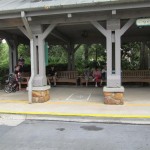
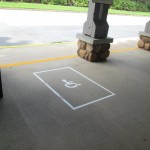
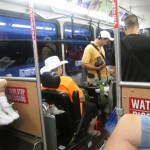
Accessible restrooms throughout every park.
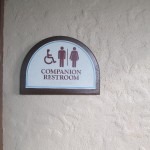
Ramps along all routes.


Lifts and other means of entry in the swimming pool areas at each of the resorts.
Accessible dining surfaces and seating at the attractions in abundance.
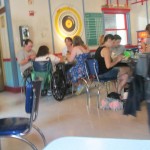
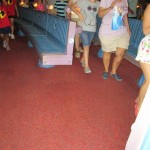
Accessible Rides
The 2010 ADA devotes an entire section to creating accessible amusement park rides. With special spaces designated for people in wheelchairs, companion seats, accessible loading areas and ramps, Disney passed with flying colors.
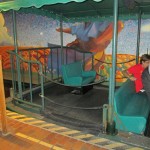
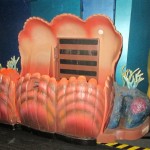
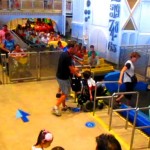
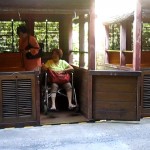
Dreams Come True…For Everyone
I’m pleased to share that our first family trip to Disney World was a rousing success. Disney has created an accessible place where everyone can enjoy a magical experience, including my family, who, I’m proud to say, survived the entire vacation with their “crazy mom on a mission.”
Because the standard requirements for amusement parks are very detailed, I encourage you to study the 2010 ADA. You may also read more in my books:
“The ADA Companion Guide”
“Applying the ADA” published by Wiley.
They are available for sale now. (also available as an e-book)
July 26th, 2015 was the 25th anniversary of the ADA. On July 23rd the AIA Dallas organized an awareness day exercise called “Wheelchair in A Day” where we asked 10 architects to sit in a wheelchair and record their experiences throughout the day. The day was a huge success and the stories they retold were so important. This newsletter will give you a few examples of the participants.

Thank you to Bob Bullis, AIA; Beth Brandt, AIA; Daivd Dillard, FAIA; Bob Borson, AIA; Peter Darby AIA, Laurel Stone, Amanda Adler, Jason Dugas, AIA for participating and for sharing your experience with the rest of us!
Traveling by Airplane on a wheelchair
AIA Dallas President Bob Bullis, AIA participated in the “Wheelchair for a Day” event. He had a meeting in Houston which he decided to keep. So he flew in his wheelchair and tweeted about his experience. We asked him what was his biggest challenge. He told us about his trials with TSA….and I will not get into the “search” pat down he received…Southwest Airlines was very accommodating, and allowed him to remain in the chair so he could experience what it was like. He got to go to the front of the line and board first.

He liked the feel of the Terrazzo flooring the best….easier to push on. But noticed that even the slightest slope was hard to navigate
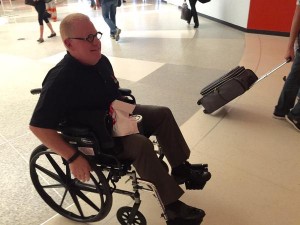

Being in the office and going out to lunch
Two architects experienced their day in a wheelchair: Bob Borson, AIA and David Dillard, FAIA
Bob Borson, AIA experienced his day in the office doing his typical duties: making copies, taking drawings from his car to his desk, and even going out to lunch. All a very eye opening experiences….read his blog post for a more detailed account
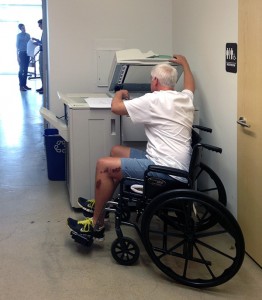
I bet Bob was glad that the doors of his office had the proper widths and maneuvering clearances

When Bob wen out to lunch here is what he experienced
“Next challenge? Going out to lunch. Again, long arms to the rescue, but I am acutely aware of how freakishly long my arms are and as a result, I am acutely aware of how difficult going through a cafeteria line would be for people who don’t have the physical proportions of a simian. “
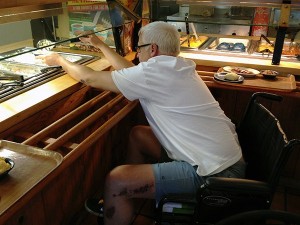
Taking the tray back to his table was a big challenge…glad he didn’t drop his food!
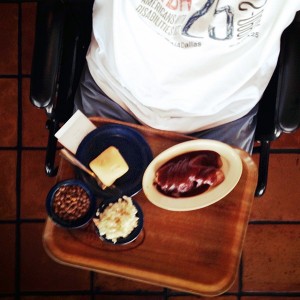
when he got to his table he noticed that there was no place for a wheelchair except at the end….he made everyone move and find a better table (It’s good to be the boss)
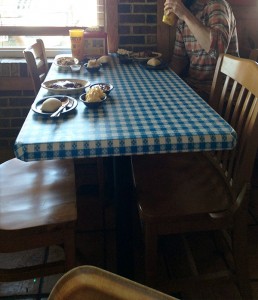
David Dillard, FAIA also stayed in his office and also experienced his daily routine in a wheelchair. Meetings are easier when you are the designer of the office and make accommodations…Good job David!
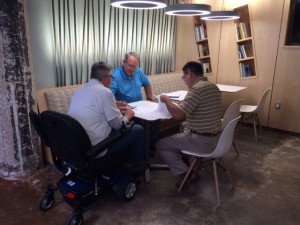
David also had doors he had to maneuver…although his experience was different since he had an electric wheelchair
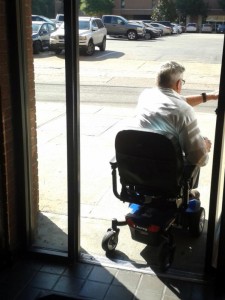
The City of Dallas didn’t plan properly the locations of stop signs and fire hydrants. David found them right in the middle of his accessible route. I bet those were fun to maneuver.

At lunch they found a restaurant with a wheelchair lift that accommodated him so he could dine with his colleagues
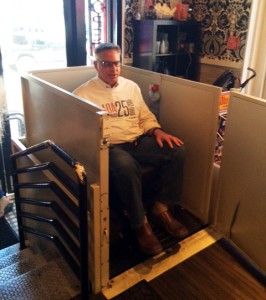
Experiences like these makes architects and designers more sensitive to the people they are designing for.
Taking public transportation
The last example was of our friend Peter Darby, AIA who decided to spend his day in a wheelchair navigating the public transportation system in the City of Dallas
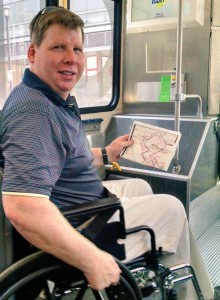
Peter rode in buses, light rail, taxis and even Uber
“Quite a few impediments today. Blocked, Crooked pavements or sidewalks to nowhere! “

He experienced getting onto light rail via ramps
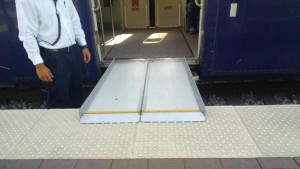
And buses
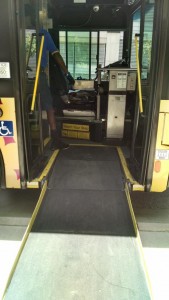
Getting assistance from rail operators
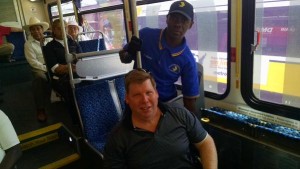
It takes so much longer to get from point A to point B when you are in a wheelchair taking public transportation, but most people with disabilities, especially visually impaired people use public transportation to get around. It is so important that we have these accommodations to enable them to be independent and as sense of dignity and empowerment.
Upcoming Continuing Education Opportunities
August 7, 2015 Accessibility Professionals Association Regional training Plano, Texas
8:00 – 10:00 am- Difference between TAS and ADA Standards- 2 CE/LU/HSW
10:15 am -11:15 pm- Retail Stores and Spaces- TDLR 1 CE #13464, AIA #155 1 LU/HSW- Detail Review of Retail Spaces Barrier Removal;Common errors; Path of Travel Requirements; Retail Accessible Parking and Accessible Routes,
An ADA Case Study of Existing & Remodeled Interiors
11:00 a.m. and 1:00PM
If you are interested in Building Code seminars check out my colleague Shahla Layendecker with SSTL Codes
If you want to learn more about these standards, be sure to check out my books:
“The ADA Companion Guide” “Applying the ADA” published by Wiley.


They are available for sale now. (also available as an e-book)
If you have any questions about these or any other topics, please feel free to contact me anytime.
Marcela Abadi Rhoads, RAS #240
Abadi Accessibility
214. 403.8714
marhoads@abadiaccess.com
www.abadiaccess.com
Useful Links





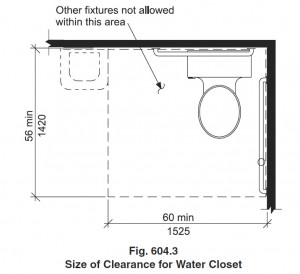
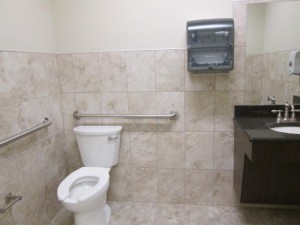

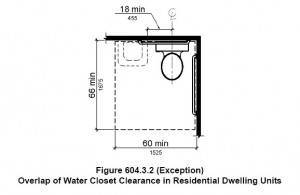

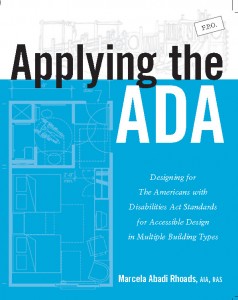



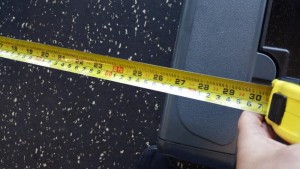




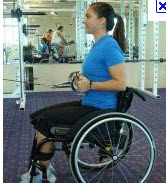
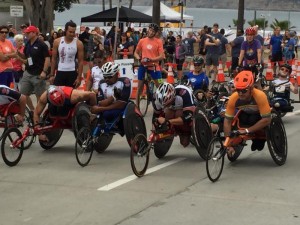
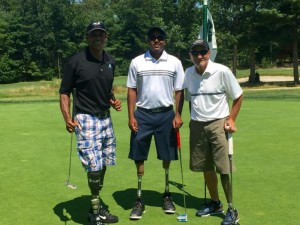
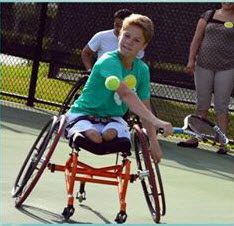
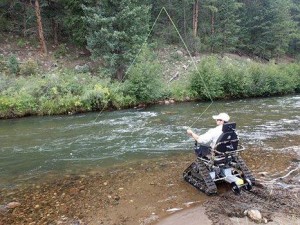


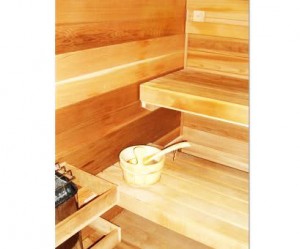
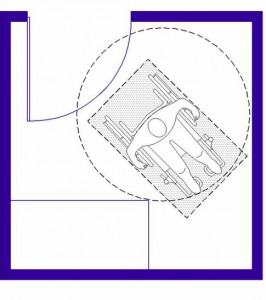
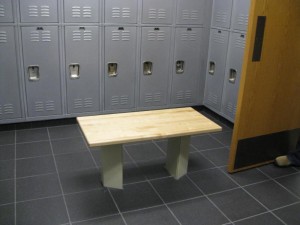
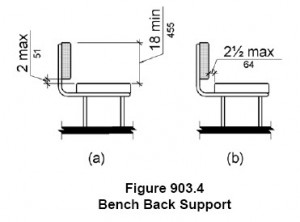
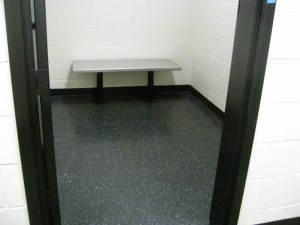


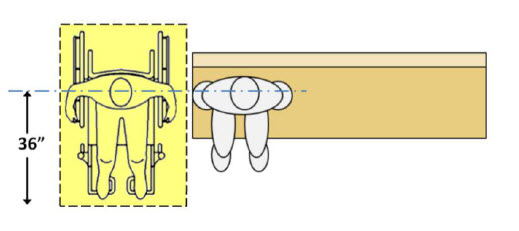
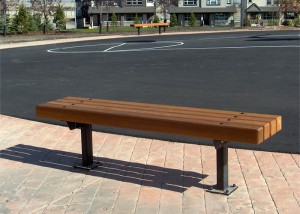
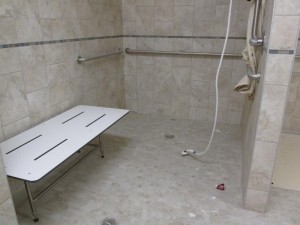

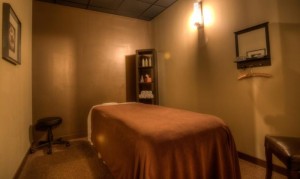


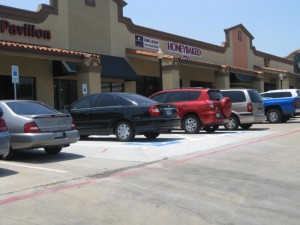



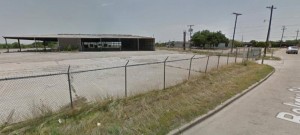


 Abadi
Abadi 

